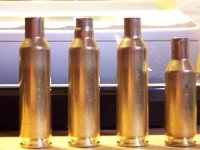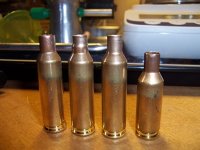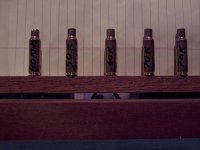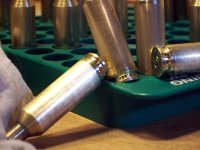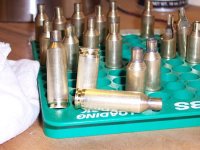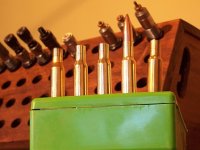Al,
I have seen this several times, never my own stuff but other long range shooters. It has always been a mystery to me. At the time I came to the conclusion that the pressure was not sufficient to seal the neck to the chamber but then that never made good sense cause why would the pressure want to get between the case neck and the chamber wall anyway. They do look like they are getting sucked in as you state. It's not something I want to see on my own stuff what ever the cause.
The 6x47L is quite interesting in that some are getting awesome results while others including seasoned shooters have tried it and have gone back to the 6BR variants because they say it was not as accurate. I think they just did not test enough to find the best loads, possibly they were shooting it too mild. You have shot both, do you have any opinions why some may be failing to acheive the stellar performance from the 6x47L?
OK, on the subject of cases "sucking flat," this is really rare but I've heard of it from two people and read of it. The concensus of opinion is that the bullet starts down the bore and pressure falls so quickly that burn cannot be sustained.
The other thing, dents in the cases from too low pressure a load is very common. It doesn't look at all like the "sucked flat" stuff. It DOES look like creases in the case, sometimes running clear down to the casehead. I've seen cases scalloped or fluted 4-5 times like they'd been drug into a knothole........and dents and dings like you'd ironed the outside of the case with a smooth mandrel or something. When pressure is too low the neck fails to seal and gas escapes down alongside the case. I've seen this MANY times. The clue is SOOT and lots of it. Blackened cases, weird smell and sometimes even a tarry sludge that I'm at a loss to account for. Here's why this one is scarey...... IT HAPPENS MAINLY TO CAREFUL PEOPLE!! I've seen it too many times where a very cautious NEW reloader just decides that in the interest of safety they'll start out "below minimum"...... and WHAMM!! .....Blowby, blowBACK and collapsed cases. IF THE CASES ARE SOOTY and smoke is rising then the load is too light!

(Or just too slow powder.) This is one of the problems that I have with slow powder in general. I growed up in MinnDesota where you can be shooting below zero..... I've seen factory rifles collapse factory loads in cold weather. Smoke rolling, eyes watering, deers running away and one very pissed off magnum owner! In fact, reloading for magnum hunting rifles in MN using light neck tension will get you sooner or later. You've got to load TIGHT and even crimp the necks. THIS is what crimping necks is really about. It's not all about just holding the bullets in place in the mag. The reason that the gas goes backwards is because it finds this to be the path of least resistance, the bullet's in the way the other way!
So many times we forget we brass case's PRIMARY FUNCTION..... gasket.
As far as my speculation as to WHY the 6X47L gets less accuracy for some people??? Yeahhh, I have opinions




(betcha' din't see THAT one coming

)
Let's look at it another way..... Why does the 6PPC dominate so much in it's discipline??? Is it a magical mixture of angles and capacities and vortices???
I say NOT!
Yes it's dimensioned correctly (but so's a WalDog)
YES it has the proper primer and flashhole...... but so do others.
Another view,related, WHY do so many folks report that "DAshers" and BRX's and such actually shoot BETTER than the parent case?
I'll tell ya' why!
(Actually, I'll give you MY OPINION why


)
IMO, the Actual Factual SECRET of the PPC is brass prep. Trial and error and time and the combined experience of a bunch of far-thinking gunsmiths/shooters have resulted in a SYSTEM that produces good brass. And the single biggest factor is that PPC's utilize crush-fit fireforming.
Short-chamber a 6BR and crush the brass, short-chamber ANYTHING and see the difference.
The factory formed PPC will NEVER be a factor because THE SECOND someone produces formed PPC cases the local populace will "chamber for it" using "GO Gauges" and the brass will quickly develop a reputation for "not shooting"..... JUST like every other factory case, 6BR included!
Because they will not agg.
Because ANYTHING, PPC included that's fireformed in a sloppy chamber cannot shoot to capacity.
Cases will banana....
Caseheads will be crooked....
It will take three tries to hammer the brass into some semblance of shape AND IT WILL NEVER SHOOT RIGHT!!
This is sooo simple. CRUSH that brass, HAMMER it with a stout fireform load of FAST powder using a LIGHT bullet and it will just fall out in your hand. And it will be forevermore tractable and dependable.....
And it won't grow....
And it won't feel different each time you size it.....
And it won't have to be annealed to make all the cases "similar"....
It'll all be identical, from the start.
and consequently your vibrations will be all GOOD vibrations.
Und't birds will tsing,
Und't flowers will ploom
Und't aggregates will shrink magically.......
Und't all will be right with the world.....

So that's MY opinion!
LOL
al


